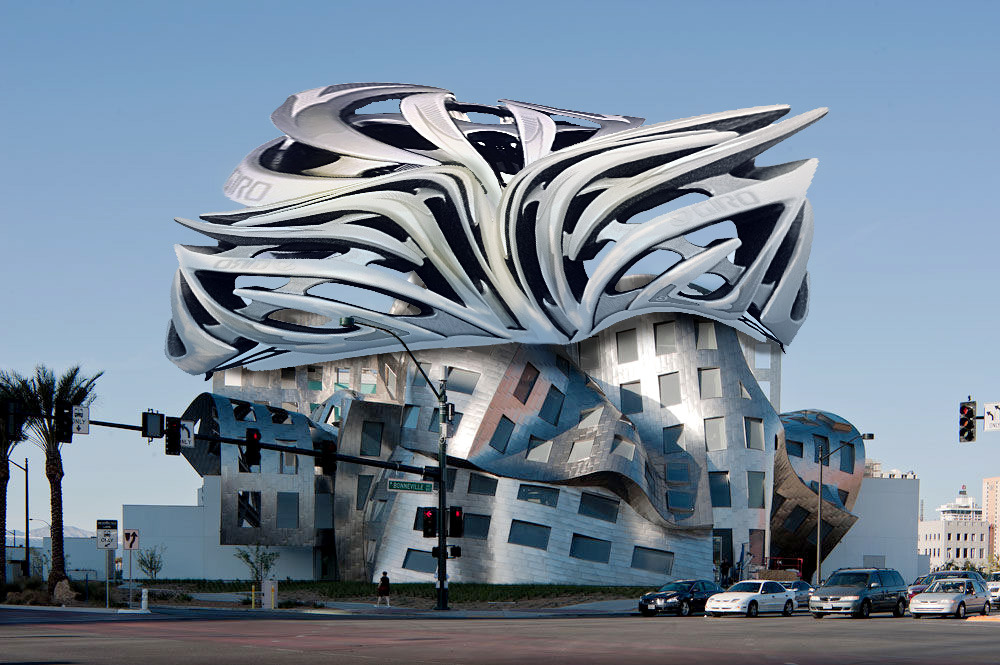
How exactly did this helmeted piece of postmodern architecture come to exist? I don’t remember precisely. Friend and fellow transpoblogger Gary Kavanagh stayed with us for a night on a recent visit to Portland, and there was a conversation over breakfast the next morning which involved a lot of laughing, and then suddenly Gary is sending me photoshopped buildings and funny captions and I’m laughing too hard to say anything but “Just post them already!!!” and he does.
Anyway, you really have to read the captions to get it. It’s all right here.
Something must be in the air, because in the last couple of weeks I’ve been finding myself in several unrelated, more serious conversations about bicycle helmets.
I came away from researching a feature article on the topic last year feeling more confused than when I went into it. One of the people I’ve been emailing with is Koula Redmond, a bicycle advocate we met on tour in Jacksonville, Florida, who expressed misgivings about helmets similar to the ones I feel — they’re designed to protect us from very specific and limited types of impact, but the rhetoric on both sides is flying so fast and furious that it’s hard to come to a clear decision. And it was nice to hear Redmond’s perspective, because like me she has sympathies on both sides and has chosen not to choose.
The pro- and anti- helmet activists are equally, ferociously sure of their scientific and moral high ground, and both deploy a mix of good and seriously skewed and incomplete stats to make their cases. In practice, I find myself in equal disagreement with both sides.
I wear a helmet most of the time when bicycling because the evidence, albeit anecdotal, presented by health care worker friends scares me utterly. It scares me so good that the only thing that prevents me from wearing one at other times when I’m in or around cars is that I don’t relish the idea of being that lady with her helmet on walking down Powell. The risks of head injury are significant by any mode, and it’s a relief at times that it’s socially acceptable to wear a helmet at least while on a bicycle.
On the other hand, I don’t always wear my helmet because the damn things are uncomfortable, the chances of it being needed feel reasonably slim, and there is also something to the points of the anti-helmet faction—for instance, there is some tenuous evidence that without a helmet, you’re perhaps perceived as more vulnerable and given a bit more breathing room. The anti-helmet people also like to say that not wearing a helmet helps normalize bicycling. But helmets are the norm here in Portland, and not wearing one while cycling inevitably attracts notice and commentary; I tend to go helmetless primarily when doing something that’s already a bit outlandish, like dressing up to the nines or hauling furniture or people.
Either way, my main objection to both the pro- and anti-helmet rhetoric is that it seems sadly inhuman to try to live life by any scientific statistical calculation of safety. The helmet debate is at core an argument about what is the most rational way to live your life. In the two sides’ juxtaposition you can see the vein of irrational absurdity that may rightly be the real basis of our society.
One thing that is certain is that all-ages mandatory helmet laws do more harm than good, reducing the amount of cycling and therefore its safety in any given place. Redmond compared helmets with sharrows—an easy, cheap, way for advocates and politicians to act, even if the effect is more symbolic than useful or safe.
Which brings me back to Gary’s blog. The way helmets are often promoted and legislated as the be-all of bicycle safety is beyond absurd (with a less-funny element of misdirected blame), and I love the way these photos and captions demonstrate that. But I hate the similar nagging tone taken by the anti-helmet folks, informing us that our social responsibility is to ride helmetless, preferably in outfits more expensive than our bicycles.
What would happen if we dropped the stats and postures and worked together on the most irrationally plausible goal of all — eliminating the issue of traffic safety entirely? Cars, speed, drunkenness, distraction and roads are the real problem here, and there are more terrifying numbers to back that up than any helmet-debater can boast of. It would be easier to see that, though, if we stopped railing against the styrofoam hat industry and each other.